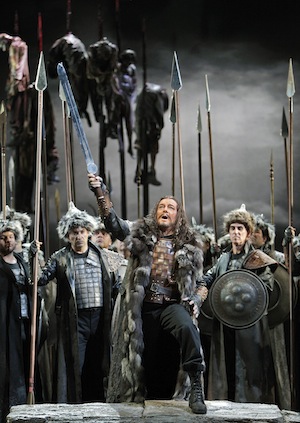
Barbarians at the gates of Rome
A friend of mine once said she liked Italian opera because the characters were either praying or kissing.
She clearly hadn’t been to see Verdi’s “Attila”, or perhaps she simply closed her eyes when everyone drew his sword. Not to say that “Attila” is all cutting and slicing. There is some romance, of a sort, though definitely no kissing. And it certainly has its fair share of praying, especially in the confrontation between Attila and Pope Leo the Great (Samuel Ramey) leading his acolytes (the sonically lovely San Francisco Girls Chorus) at the gates of Rome. But Attila is at heart a political opera, meant to bolster the cause of the Italian Risorgimento, or unification. Written in 1846 for production at La Fenice, the principal Venetian opera house, it came on the heels of the Austrian possession of the Venetian Republic in 1815.
The story lightly traces Attila the Hun’s invasion of Rome in the 5th century. It has the popular and enticing trope of the sexy barbarian (who by the way was not likely to have worshipped the Nordic god Odin except by default). And Verdi was happy to add a Roman warrior princess right from the get-go. Enticed by the bravery of the saucy Odabella (lusciously sung by soprano Lucrecia Garcia), Attila gives her the sword that she will later kill him with. Attila is sung by bass Ferruccio Furlanetto in this production, which San Francisco Opera shares with Teatro alla Scala, and the Italian bass was simply terrific in all ways.
Right up there with Furlanetto in expressive male vocal beauty and theatrical presence was Quinn Kelsey, who sang Ezio, the Roman diplomat who is willing to sell Rome to Attila if only he can keep Italy for himself.
Tenor Diego Torre sings Foresto, Roman patriot and jealous lover of Odabella, putting in an accomplished but rather domesticated performance.
Venice and Italy have been occupied, divided and sorted out many times in their history. And what power-hungry mob wouldn’t want to possess such a beautiful country, with a culture that has been unfailingly exquisite in spite of its tumultuous political history? This production, staged by Gabriele Lavia with sets by Alessandro Camera and costumes by Andrea Viotti, celebrates the 150th anniversary of Italian unification. Each act is placed in a different period of Italian history: the first act is set amid the ruins of a classical Roman amphitheater, the second act in a 19th-century Italian opera house, and the third in a contemporary movie theater. A carefully thought-out concept, playing with the idea of history as an evanescent event of theater, it allows for sets that are both traditional and beautifully realized.
The singers might have been better served in the third act, however, if the modern day theater had run a little less of the thrilling 1954 movie, “Sign of the Pagan”, with Jack Palance as Attila. I was totally seduced by his tilted eyes and Ukrainian cheekbones. Looked like a Hun to me, especially in black-and-white. After 15 minutes I was ready to run out the door and rent the movie.
—Jaime Robles
San Francisco Opera’s production of Giuseppe Verdi’s “Attila” continues through July 1. Sung in Italian with English supertitles.
War Memorial Opera House, 301 Van Ness Ave., San Francisco. www.sfopera.org. 415-864-3330.
Photo: Ferruccio Furlanetto leads the Huns in San Francisco Opera production. Photo by Cory Weaver.
